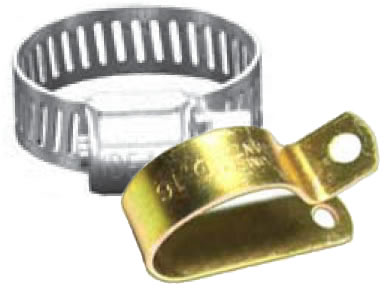 Hoses are commonly used in both automobiles and airplanes. Consisting of rubber tubes, they are designed to carry liquid — coolant, oil, etc. — to different parts. When connecting a hose to a part, though, a clamp may be required.
Hoses are commonly used in both automobiles and airplanes. Consisting of rubber tubes, they are designed to carry liquid — coolant, oil, etc. — to different parts. When connecting a hose to a part, though, a clamp may be required.
Clamps are fasteners that are designed to seal the end of a hose around the part with which it’s used.
What Are Worm Gear Clamps?
One of the most common types of hose clamps is worm gear. Also known as screw clamps, they feature a captive screw that’s secured to a band of material. Most worm gear clamps are made of metal. You can find them galvanized steel, stainless steel, aluminum and brass.
Installing a worm gear clamp requires placing it over the hose. Once placed over the hose, you can use a screwdriver to tighten the captive screw. Tightening the captive screw will pull the band of material so that it becomes smaller. A smaller band, of course, will result in a tighter connection around the hose.
What Are Spring Clamps?
Spring clamps are hose clamps that feature a spring-like design. They still feature a band of material, but they don’t have a captive screw. Instead, spring clamps consist of a semi-elastic band of material that works like a spring.
To install a spring clamp, you’ll need to loosen it. Most spring clamps have two tabs on one end and a single tab on the opposite end. Using a pair of pliers, you can press these tabs together to loosen the spring clamp so that it becomes larger. You can then slide the spring clamp over the hose. After releasing the pliers from the tabs, the spring clamp will revert back to its original “clamped” position.
Differences Between Worm Gear and Spring Clamps
Worm gear clamps and spring clamps aren’t the same. They are two different types of hose clamps that work in different ways. Worm gear clamps are characterized by a captive screw. You’ll have full control over the tightness of a worm gear clamp thanks to this captive screw. If the worm gear clamp is too loose or too tight, you can adjust the captive screw with a screwdriver.
Spring clamps don’t offer this same level of control over the tightness. You can open them by pinching the tabs with a pair of pliers. Releasing the pliers will cause the spring clamp to apply pressure to the hose. Nonetheless, spring clamps don’t have a captive screw, so you can’t adjust the tightness.



